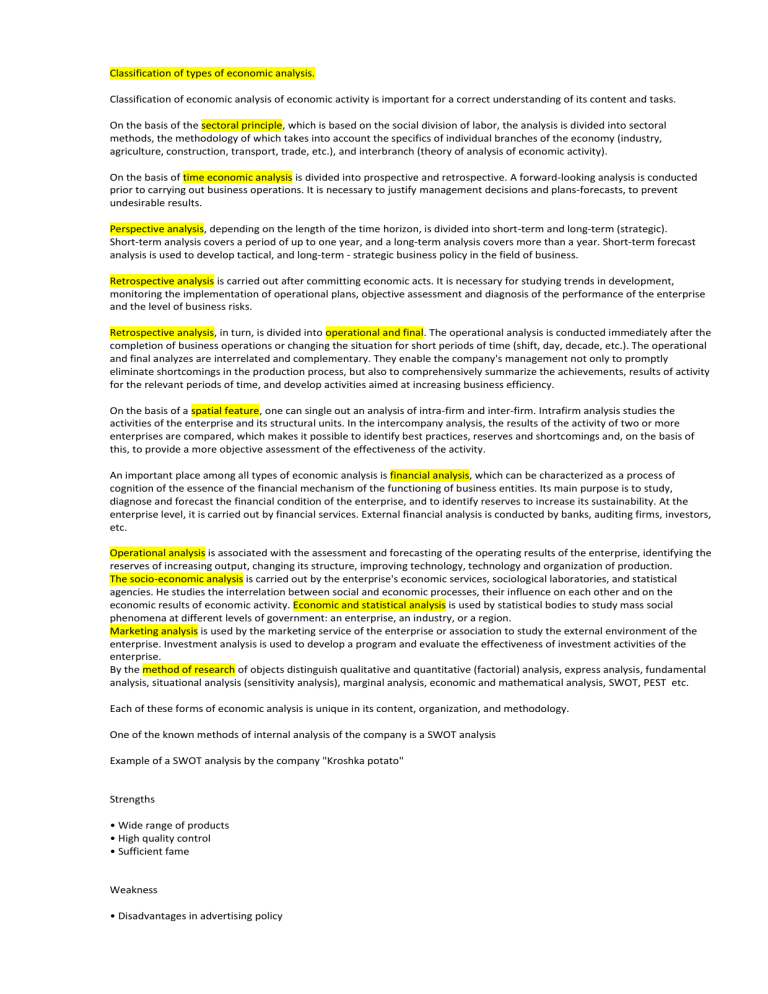Classification of types of economic analysis.
advertisement

Classification of types of economic analysis. Classification of economic analysis of economic activity is important for a correct understanding of its content and tasks. On the basis of the sectoral principle, which is based on the social division of labor, the analysis is divided into sectoral methods, the methodology of which takes into account the specifics of individual branches of the economy (industry, agriculture, construction, transport, trade, etc.), and interbranch (theory of analysis of economic activity). On the basis of time economic analysis is divided into prospective and retrospective. A forward-looking analysis is conducted prior to carrying out business operations. It is necessary to justify management decisions and plans-forecasts, to prevent undesirable results. Perspective analysis, depending on the length of the time horizon, is divided into short-term and long-term (strategic). Short-term analysis covers a period of up to one year, and a long-term analysis covers more than a year. Short-term forecast analysis is used to develop tactical, and long-term - strategic business policy in the field of business. Retrospective analysis is carried out after committing economic acts. It is necessary for studying trends in development, monitoring the implementation of operational plans, objective assessment and diagnosis of the performance of the enterprise and the level of business risks. Retrospective analysis, in turn, is divided into operational and final. The operational analysis is conducted immediately after the completion of business operations or changing the situation for short periods of time (shift, day, decade, etc.). The operational and final analyzes are interrelated and complementary. They enable the company's management not only to promptly eliminate shortcomings in the production process, but also to comprehensively summarize the achievements, results of activity for the relevant periods of time, and develop activities aimed at increasing business efficiency. On the basis of a spatial feature, one can single out an analysis of intra-firm and inter-firm. Intrafirm analysis studies the activities of the enterprise and its structural units. In the intercompany analysis, the results of the activity of two or more enterprises are compared, which makes it possible to identify best practices, reserves and shortcomings and, on the basis of this, to provide a more objective assessment of the effectiveness of the activity. An important place among all types of economic analysis is financial analysis, which can be characterized as a process of cognition of the essence of the financial mechanism of the functioning of business entities. Its main purpose is to study, diagnose and forecast the financial condition of the enterprise, and to identify reserves to increase its sustainability. At the enterprise level, it is carried out by financial services. External financial analysis is conducted by banks, auditing firms, investors, etc. Operational analysis is associated with the assessment and forecasting of the operating results of the enterprise, identifying the reserves of increasing output, changing its structure, improving technology, technology and organization of production. The socio-economic analysis is carried out by the enterprise's economic services, sociological laboratories, and statistical agencies. He studies the interrelation between social and economic processes, their influence on each other and on the economic results of economic activity. Economic and statistical analysis is used by statistical bodies to study mass social phenomena at different levels of government: an enterprise, an industry, or a region. Marketing analysis is used by the marketing service of the enterprise or association to study the external environment of the enterprise. Investment analysis is used to develop a program and evaluate the effectiveness of investment activities of the enterprise. By the method of research of objects distinguish qualitative and quantitative (factorial) analysis, express analysis, fundamental analysis, situational analysis (sensitivity analysis), marginal analysis, economic and mathematical analysis, SWOT, PEST etc. Each of these forms of economic analysis is unique in its content, organization, and methodology. One of the known methods of internal analysis of the company is a SWOT analysis Example of a SWOT analysis by the company "Kroshka potato" Strengths • Wide range of products • High quality control • Sufficient fame Weakness • Disadvantages in advertising policy • Average price level • Not full capacity utilization Opportunities • Improvement and variety of dishes • Reduction of prices for products and raw materials • Growth of the company network Threats • The emergence of fundamentally new technologies in cooking that may require a complete replacement of the equipment of the company • Decrease in living standards of population, growth of unemployment, growth of rates of inflation and taxes • Emergence of new competitors in the fast food market and increase of competitive advantages from new firms
